Intel NUC5i5RYK Review: A Broadwell-U UCFF PC for Enthusiasts
by Ganesh T S on February 20, 2015 8:00 AM ESTGaming Benchmarks
Intel's integrated GPUs don't have a big name in the gaming community. Once in a while, Intel throws in a surprise. In the Haswell family, CPUs with Iris Pro graphics gave a pleasant surprise to casual gamers. In this section, we will identify whether the Intel HD Graphics 6000 in the Core i5-5250U can provide an acceptable gaming experience. It will also be interesting to determine whether HD 6000 can provide better numbers compared to the HD 5500 in the Core i7-5500U (BRIX s).
For the purpose of benchmarking, we chose four different games (Sleeping Dogs, Tomb Raider, Bioshock Infinite and DiRT Showdown) at three different quality levels. As someone focusing on HTPCs and multimedia aspects, I rarely get to process gaming benchmarks, even while evaluating GPUs. One of the aspects that I feared was spending lot of time in installing the same games again and again on different PCs under the review scanner. The solution was to go the Steam route. Unfortunately, Steam also likes to keep the game files updated. A quick online search revealed that Steam could make use of an external drive for storing the game executables and downloadable content. With the Steam drive on-the-go use-case being read-heavy, the Corsair Flash Voyager GS USB 3.0 128GB Flash Drive (with read speeds of up to 275 MBps) was ideal for use as a portable Steam drive.
Sleeping Dogs
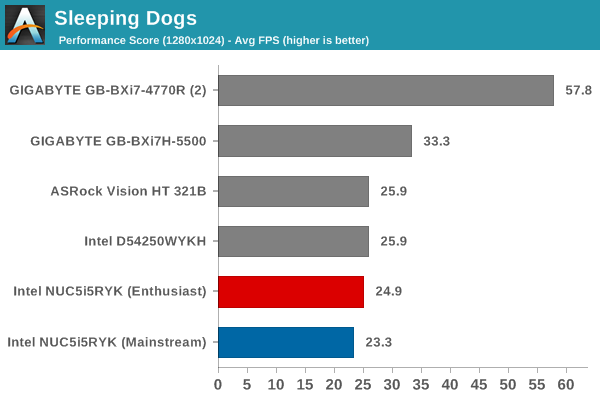
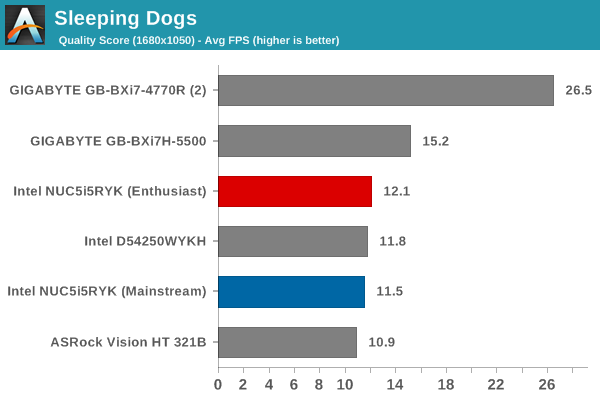
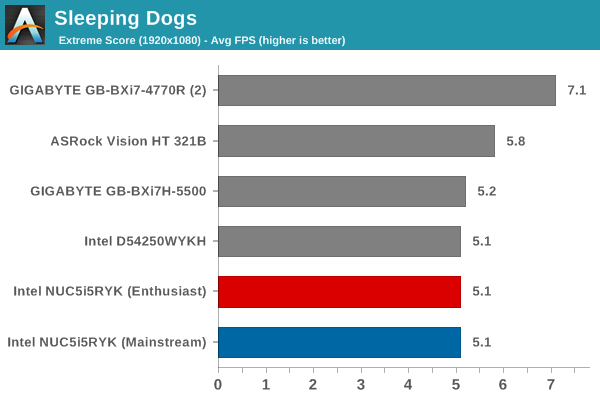
Tomb Raider
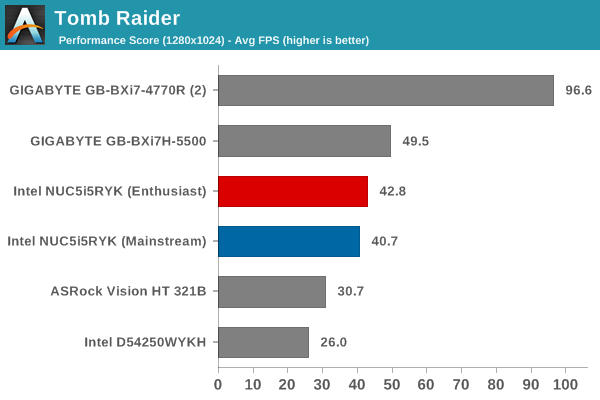
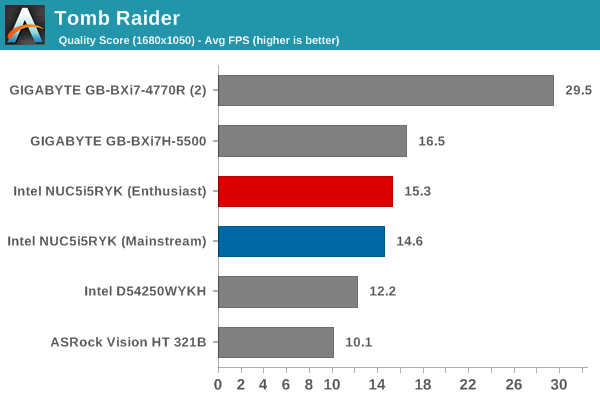
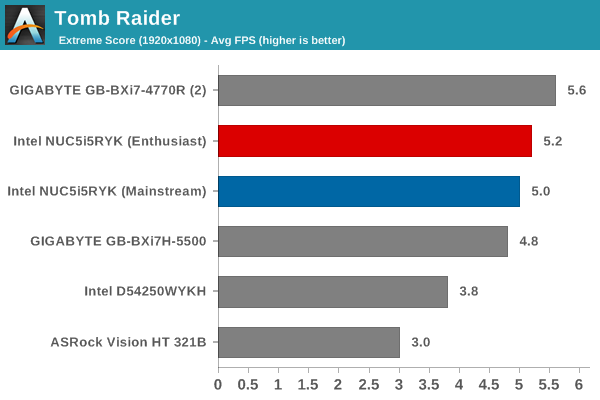
Bioshock Infinite
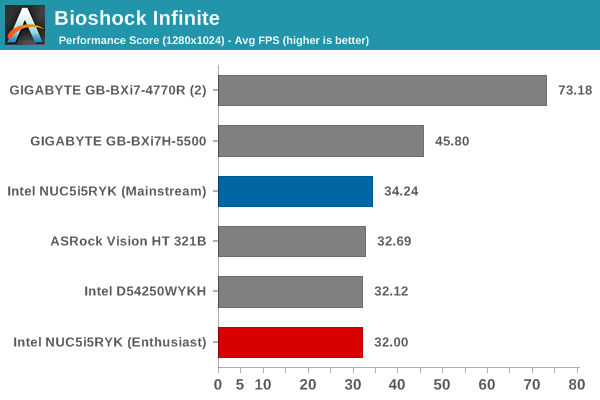
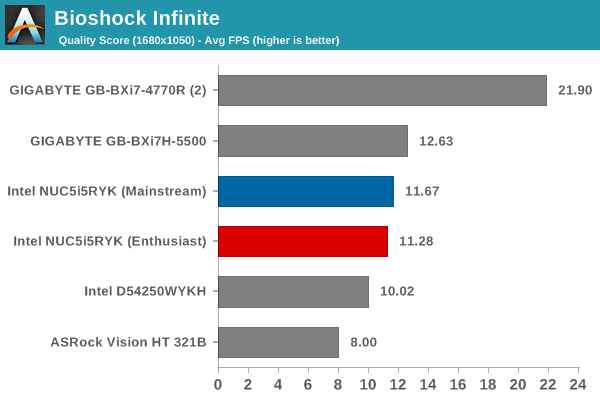
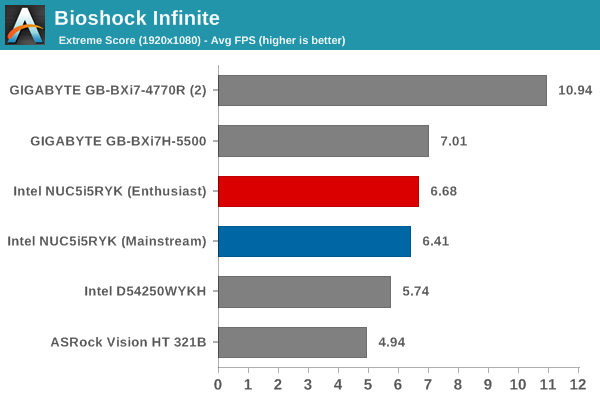
DiRT Showdown
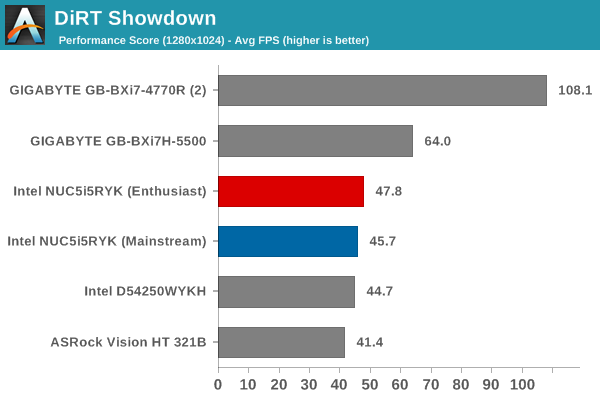
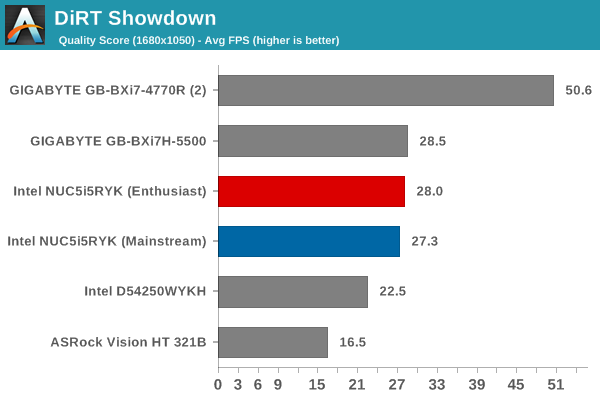
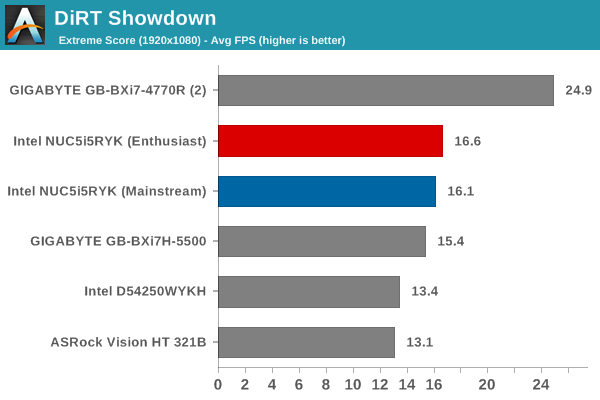
The gaming benchmarks, when considered as a showdown between the HD Graphics 5500 and HD Graphics 6000, is is a complete walkover for the former in the Core i7-5500U. Faster memory helps in salvaging a few FPS here and there, but the games are not fluid even with all settings dialed down. One aspect to be kept in mind while considering the above results is that the HD 5500 in the Core i7-5500U had accesses to DRAM running at 2133 MHz, while the HD 6000 in the NUC5i5RYK was limited to 1866 MHz.










83 Comments
View All Comments
smegforbrain - Saturday, February 21, 2015 - link
Agreed. We initially bought a D34010WYKH1 (i3) at work as a test device last summer to see how well they worked. A couple of our employees have been using them for more than 6 months now.I ended up buying a D54250WYKH1 (i5) for myself to use at home as a media PC and other uses. I'm very happy with it, but I am slightly disappointed that they didn't go with full HDMI for the Broadwell refresh.
mavere - Friday, February 20, 2015 - link
VP9 hybrid acceleration is enabled in recent Intel Broadwell drivers, and apparently Chrome 41+ (currently in Beta) has the ability to hook into Intel's VP9 decoder.In future Broadwell tests, can you check Youtube power consumption with Chrome 41+? Chrome defaults to VP9 on so most Youtube videos nowadays, so this is an important and unexplored area for mobile power usage.
TrackSmart - Friday, February 20, 2015 - link
I don't much of a performance difference between the "mainstream" and the "enthusiast" versions used in this article (aside for artificial SSD benchmarks). Of course, the price difference between the configurations is only $66.Really the biggest performance difference among all of the candidates is between the one machine that has a spinning hard disk and all of the rest. Worth knowing none-the-less.
Essence_of_War - Friday, February 20, 2015 - link
Should I be getting the message that intel not want us to use thunderbolt?Jaybus - Saturday, February 21, 2015 - link
No. It is a matter of power. Thunderbolt standard specifies that every port supply 10 W of DC power. Also, the controller itself is very high bandwidth and requires > 2 W. It adds up on a system striving to be low power and fanless.Samus - Friday, February 20, 2015 - link
Wow Intel has the cleanest uefi bios interface I've ever seen. Shame they don't make motherboards anymore :(A4i - Saturday, February 21, 2015 - link
I got the old i5-4200U , mounted on industrial PC chassis (half inch thick aluminum side panel/radiator). It gets extremely hot, when operating at max CPU load (and ~0 GPU load). Don't hold you breath for power efficiency and productivity. Also that platform lacks any overclocking settings in BIOS or OS tools and is frustratingly painful to undervolt.KAlmquist - Saturday, February 21, 2015 - link
A benchmark question:The "enthusiast" version has 10-10-10-32 1866Mhz memory, while the "mainstream" version has 9-9-9-27 1600Mhz memory. So the difference in memory could account for at most a 17% difference in performance between the two versions (1866Mhz/1600Mhz). But the Cinebench R15 3D rendering multi-threaded benchmark shows the "enthusiast" version to be 34% faster, and the 7-Zip LZMA Decompression benchmark makes the "enthusiast" version 30% faster.
The only other difference between the two versions is the choice of SSD. This could in principle explain the differences listed above, but that would mean that the two benchmarks cited are largely disk I/O bound since we see the effect even with relatively fast disk drives (SSD rather than mechanical) and a relatively slow CPU (1.6 Ghz dual core). I thought those benchmarks were intended to measure computational throughput, and thus should not be affected by the storage subsystem at all. Am I wrong?
Kidster3001 - Friday, February 27, 2015 - link
If you're looking for a pur CPU benchmark that doesn't rely on other parts of teh system then you'll end up with synthetics that everyone complains about because they don't reflect the real world.Yes, Archive applications rely very heavily on I/O. If you want to use them for CPU benchmarks you should set up RAM Disks for the storage.
On a similar note, one of my pet peeves is using browser benchmarks to compare CPUs. Browser benchmarks measure the performance of the browser and it''s engine(s). They do very little good as a CPU comparison tool. Sunspider for instance can score wildly different on the exact same system just by using a different browser.
gfieldew - Saturday, February 21, 2015 - link
Could the FHD model drive a 4K TV/Monitor adequately? I'm not expecting HDMI 2.0 but 60Hz would be good. Thank-you!